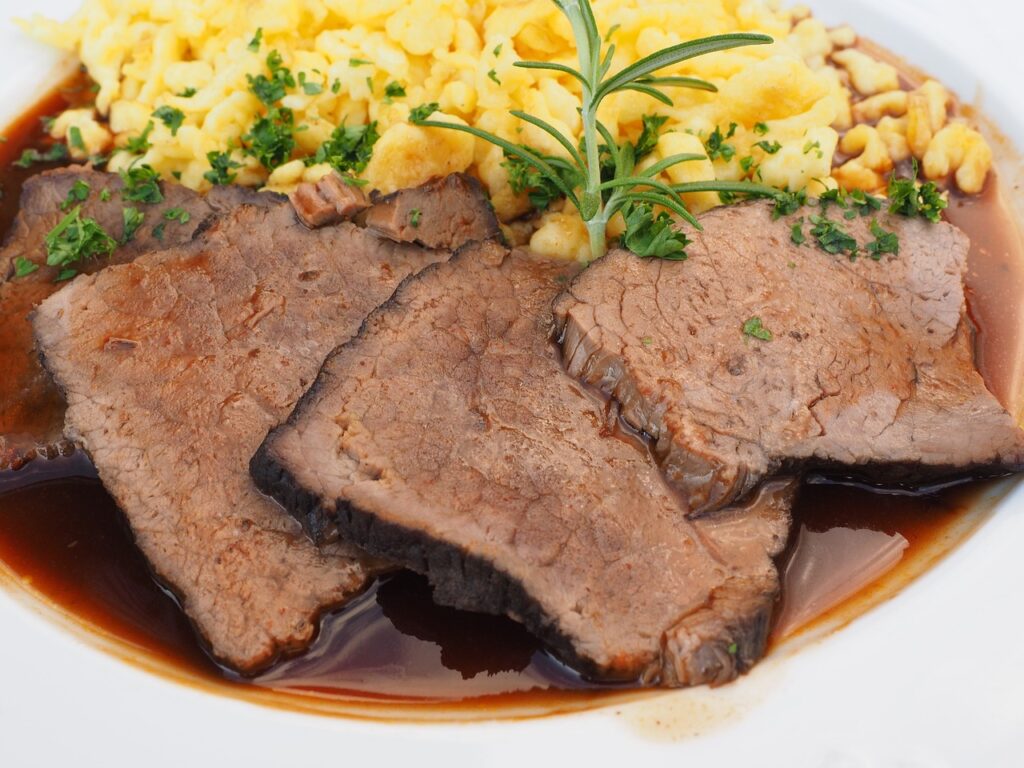A Culinary Exploration of Europe Trip
Europe, a continent wealthy in history, way of life, and culinary variety, gives a completely specific adventure via its scenic landscapes, historic landmarks, and myriad flavors and dishes. Each United States gives its very own culinary narrative, deeply rooted in traditions and history. This manual invites you on a culinary adventure all through Europe trip, exploring five dishes that promise a real taste in their fatherland.
Greece: Moussaka
Moussaka is a testament to the Greek culinary way of life, layering eggplant, minced meat, and a creamy béchamel sauce. Its origins trace back to the Ottoman Empire, evolving into the version we pride ourselves on today. For the most authentic revel, are searching out a local taverna where moussaka is prepared with a recipe passed down through generations. Insider guides on Greek food often highlight regions like Crete or the Peloponnese for the best moussaka, blending history with flavor in every bite. See the following characteristics of Moussaka below:
- Rich and flavorful layers: Moussaka offers a delightful aggregate of tender eggplant, savory minced meat, and fragrant spices, developing a symphony of flavors in each bite.
- Comforting and hearty: With its hearty texture and gratifying substances, moussaka is the correct consolation meal, ideal for warming up on chilly evenings or sharing with loved ones.
- Cultural experience: Trying moussaka allows discover the rich culinary traditions of the Mediterranean, providing a flavor of the vicinity’s diverse and colorful cuisine.

For a closer look at what you can try in Greece, have a look at our blog post to get the insider’s guide to authentic Greek food. Feast your senses with our comprehensive guide
France: Coq au Vin
Coq au Vin, a quintessentially French dish, combines chicken with wine, mushrooms, onions, and bacon, embodying the French flair for transforming sparkling ingredients into culinary masterpieces. Originating from Burgundy, this dish shows the use of the nation-state cooking of France. To enjoy a proper Coq au Vin, venture into the Alsace area, in which culinary excursions and wine tastings complement the dining enjoyment. Planning a Europe Trip? Don’t leave out on savoring this iconic French dish along your journey. The dish provides a representation of the flavor of French cuisine with a nod to its rich winemaking traditions and subculture. Below is a description of what to expect from Cog au Vin:
- French culinary excellence: Coq au Vin is an important French dish, showcasing the beauty and class of French cuisine with its mild chicken braised in red wine and fragrant herbs.
- Flavorful complexity: With its rich and complicated taste profile, Coq au Vin combines the deep earthy notes of purple wine with the wonder of caramelized onions and the subtle earthiness of mushrooms, forming the perfect flavor profile.
- Time-venerated way of lifestyles: Dating once more to medieval France, Coq au Vin has a storied history and remains a popular dish on dinner tables in France.

After savoring Coq au Vin, consider exploring Alsace’s wine culture further by reading our blog article on Alsace Wine Tasting During a Viking River Cruise for an immersive experience in French viticulture.
Germany: Sauerbraten
Sauerbraten, Germany’s celebrated marinated roast, highlights the importance of patience in German cuisine. This dish, often prepared with beef and a mixture of vinegar, sugar, and spices, is marinated for numerous days earlier than cooking, resulting in a gentle and flavorful meal. Enjoy it with red cabbage and potato dumplings for an imperative German meal. The Breisach area, known for its wine, offers an appropriate setting to pair Sauerbraten with nearby vintages, improving the culinary revel in. It’s a must-try dish during your Europe trip. Below is a list of the food tasting notes and history of Sauerbraten:
- German culinary historical past: Sauerbraten is a loved dish in German delicacies, celebrated for its particular combination of tangy flavors and hearty components, reflecting the rich culinary traditions of the area.
- Tender and succulent meat: This traditional German pot roast capabilities marinated and gradual-cooked beef, resulting in exceedingly mild and flavorful meat that melts on your mouth with each savory bite.
- Distinctive candy and bitter taste: Sauerbraten’s signature marinade, usually made with vinegar, sugar, and spices, imparts a lovely sweet and sour tang to the dish, growing a culinary revel in this is each comforting and exciting.

Complement your culinary journey through Germany with a picturesque wine tasting adventure in Breisach, by reading our blog article Wine Tasting and Scenery in Breisach on a Viking River Cruise. Breisach is a hidden gem for both wine enthusiasts and nature lovers.
Croatia: Peka
Peka, a cherished Croatian dish, is greater than a meal; it’s a culinary event. Meat and vegetables are cooked beneath a bell-like dome, and buried in embers, growing a smooth and fragrant dinner party. This cooking approach, deeply rooted in the Croatian way of life, showcases the communal spirit of Croatian eating. For the high-quality Peka, visit a konoba, a conventional Croatian tavern, wherein the dish is regularly prepared in outdoor kitchens, inviting diners proper into a shared, memorable experience during your Europe trip. See the description below which identifies the unique approach to this dish:
- Croatian culinary delight: Peka, a traditional Croatian cooking method, gradually roasts meat, vegetables, and potatoes below a metallic dome. This approach results in mild, flavorful dishes that epitomize the wealthy culinary background of Croatia.
- Rustic communal ingesting: Peka is regularly organized outdoors, bringing friends and family together. Cooking over an open fire fosters an experience of network, making the eating enjoyment memorable and fun.
- Intense flavors: The slow cooking procedure allows elements to marinate and infuse, creating wealthy, aromatic dishes that are deeply enjoyable and representative of Croatian delicacies’.
Italy: Risotto
Risotto, Italy’s most popular rice dish, varies remarkably from one location to another. Whether it’s far the saffron-infused Risotto alla Milanese or the seafood-rich Risotto al Nero di Seppia in Venice, each version tells the story of its close-by substances and culinary customs. To discover excellent Risotto, find areas famous for their particular variations, and dine in institutions that specialize in close-by delicacies. Italy’s numerous landscapes of flavors ensure that each Risotto is unique and splendid. Below is a list of the characteristics of the dish:
- Creamy texture: Risotto’s velvety feel is achieved through slow broth addition to rice.
- Versatility: Adaptable dish with endless ingredient variations to suit any palate.
- Culinary experience: Stirring rice slowly, adding broth gradually for perfect result.

What are Some Popular Foods in Europe?
Goulash (Hungary) – Stew made from veal or beef, with potatoes and vegetables.
Paella (Spain) – A medley of meat or seafood, rice, and vegetables slowly cooked in an oven.
Pierogi (Poland) – Dumplings stuffed with savory or sweet fillings including potatoes, meat, cabbage, spinach, and cheese.
Borscht (Ukraine) – A hearty soup made with beets, cabbage, potatoes, and carrots.
Pizza (Italy) – Originating in Naples, pizza is the perfect combination of tomato sauce, mozzarella cheese, and flavorful toppings, on a thin crispy crust.

What is a Typical European Lunch?
European lunch traditions vary drastically across the continent. In Mediterranean locations lunch is the day’s main meal and often served with table wine. Northern European locations can also pick lighter, faster meals, along with sandwiches or salads. The range in lunch customs offers a glimpse into the diverse rhythms of daily life throughout Europe.
How is the Food in Europe?
European food is regional and varies from bold, hearty, and complex in northern and eastern Europe. While in Mediterranean European countries food is characterized as lighter and more subtle with use of fresh local ingredients and seafood.
Conclusion:
In this case, exploring Europe through its culinary offerings is an enriching adventure that gives insights into the continent’s cultures, histories, and traditions. Each dish tells a story of the region, inviting tourists to taste their unique expression of the area. Whether it’s miles the layered complexity of Moussaka in Greece, the country beauty of Coq au Vin in France, the clean traditions of Sauerbraten in Germany, the communal spirit of Peka in Croatia, or the regional nuances of Risotto in Italy, Europe’s culinary panorama is as numerous as it is pleasant. Eat your way through Europe, and allow your tastebuds to lead the manner to unforgettable studies and memories.










